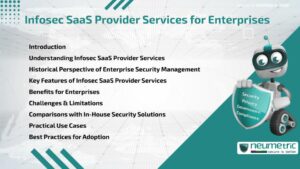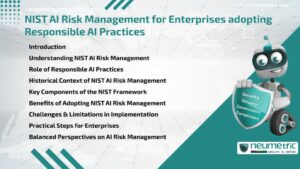Table of Contents
ToggleIntroduction
NIST AI Risk Management has emerged as a cornerstone for enterprises aiming to adopt responsible AI Practices. Developed by the National Institute of Standards & Technology [NIST], the Framework provides guidelines for identifying, measuring & managing Risks associated with Artificial Intelligence. It emphasises Trust, Accountability, Fairness & Transparency, all of which are critical to building confidence among Users, Regulators & Stakeholders. For enterprises, the adoption of this Framework ensures that AI technologies remain not only innovative but also responsible & reliable.
Understanding NIST AI Risk Management
At its core, NIST AI Risk Management helps Organisations balance innovation with Risk awareness. It provides a structured approach for identifying potential harms such as Bias, Data misuse, Cybersecurity Threats & unintended consequences. Enterprises can use the Framework to align technical design with Ethical Standards & Operational safeguards. This creates a foundation where AI can thrive without compromising trust or social values.
Role of Responsible AI Practices
Responsible AI Practices extend beyond technical Compliance. They encompass values like Fairness, Explainability, Inclusivity & Accountability. By adopting NIST AI Risk Management, enterprises can integrate these practices into every stage of the AI lifecycle-from data collection & model training to deployment & monitoring. Much like a quality control process in Manufacturing, the Framework ensures AI Systems function within Ethical & Regulatory boundaries.
Historical Context of NIST AI Risk Management
NIST has a long history of setting standards that shape industries. From Cybersecurity frameworks to Data Security guidelines, NIST has consistently provided benchmarks that Organisations trust. The introduction of NIST AI Risk Management is part of this legacy, recognising the growing influence of AI & the Risks it brings. Just as the NIST Cybersecurity Framework became essential for protecting digital infrastructure, this Framework aims to standardise responsible AI adoption.
Key Components of the NIST Framework
The NIST AI Risk Management Framework is organised into four (4) main functions:
- Govern: Establish organisational Structures, Policies & Culture for AI Risk.
- Map: Identify AI Systems, their intended uses & related Risks.
- Measure: Evaluate Risks through testing, monitoring & metrics.
- Manage: Prioritise & address Risks to align with enterprise goals.
These components help enterprises integrate responsible AI Practices into business strategy while ensuring continuous oversight.
Benefits of Adopting NIST AI Risk Management
Enterprises adopting NIST AI Risk Management benefit in several ways:
- Improved Trust with Customers, Regulators & Partners
- Enhanced ability to detect & mitigate bias in algorithms
- Stronger Compliance with Ethical Standards & Regulations
- Increased resilience against cyber & operational Risks
Much like a safety manual in engineering, the Framework provides a guide to reduce uncertainty & improve long-term sustainability.
Challenges & Limitations in Implementation
Despite its advantages, adopting NIST AI Risk Management is not without challenges. Enterprises may face difficulties such as:
- Limited expertise in AI Governance
- High costs of Compliance & Monitoring
- Complexity in aligning AI Systems across diverse industries
- Possible resistance from teams focused on speed of innovation
These challenges highlight the need for careful planning & cross-functional collaboration. Enterprises must balance the pursuit of innovation with adherence to responsible practices.
Practical Steps for Enterprises
To successfully implement NIST AI Risk Management, enterprises can follow practical steps:
- Build internal awareness through training & workshops
- Establish cross-disciplinary AI Governance committees
- Regularly assess AI Systems using NIST guidelines
- Engage external Auditors for independent evaluation
These steps mirror quality assurance programs in other fields, ensuring Accountability at every level of the Organisation.
Balanced Perspectives on AI Risk Management
While NIST AI Risk Management offers valuable guidance, it is not a one-size-fits-all solution. Some critics argue that frameworks may slow down innovation, while others stress that voluntary adoption may limit its impact. However, many experts agree that balancing innovation with responsibility is essential for long-term trust in AI. The Framework provides a flexible path that enterprises can adapt to their unique needs.
Takeaways
- NIST AI Risk Management is vital for enterprises adopting responsible AI Practices.
- The Framework emphasises Trust, Accountability & Transparency.
- It provides structured guidance through four (4) Core Functions: Govern, Map, Measure & Manage.
- Challenges exist, but practical steps can help Organisations integrate the Framework effectively.
- Balanced adoption ensures both innovation & responsibility in enterprise AI.
FAQ
What is NIST AI Risk Management?
It is a Framework developed by the National Institute of Standards & Technology to help Organisations identify, measure & manage AI Risks.
Why should enterprises adopt NIST AI Risk Management?
It ensures responsible AI Practices, builds Trust among Stakeholders & helps Organisations comply with Ethical & Regulatory Standards.
How does the Framework address AI bias?
The Framework encourages enterprises to test, monitor & measure AI Systems to detect & reduce bias in algorithms & decision-making.
What are the four (4) Core Functions of the Framework?
The functions are Govern, Map, Measure & Manage, which provide a structured approach to AI Risk oversight.
Is adoption of the Framework mandatory?
No, it is a voluntary Framework, but many enterprises use it to align with Best Practices & Industry expectations.
What challenges do enterprises face in adoption?
Challenges include costs, lack of expertise & balancing innovation speed with Compliance Requirements.
How does responsible AI differ from traditional AI Governance?
Responsible AI emphasises fairness, explainability & inclusivity, while traditional Governance often focuses more on Compliance & Technical performance.
Can Small Businesses also adopt NIST AI Risk Management?
Yes, the Framework is flexible & scalable, allowing businesses of all sizes to adapt it according to their needs.
Need help for Security, Privacy, Governance & VAPT?
Neumetric provides organisations the necessary help to achieve their Cybersecurity, Compliance, Governance, Privacy, Certifications & Pentesting needs.
Organisations & Businesses, specifically those which provide SaaS & AI Solutions in the Fintech, BFSI & other regulated sectors, usually need a Cybersecurity Partner for meeting & maintaining the ongoing Security & Privacy needs & requirements of their Enterprise Clients & Privacy conscious Customers.
SOC 2, ISO 27001, ISO 42001, NIST, HIPAA, HECVAT, EU GDPR are some of the Frameworks that are served by Fusion – a SaaS, multimodular, multitenant, centralised, automated, Cybersecurity & Compliance Management system.
Neumetric also provides Expert Services for technical security which covers VAPT for Web Applications, APIs, iOS & Android Mobile Apps, Security Testing for AWS & other Cloud Environments & Cloud Infrastructure & other similar scopes.
Reach out to us by Email or filling out the Contact Form…





